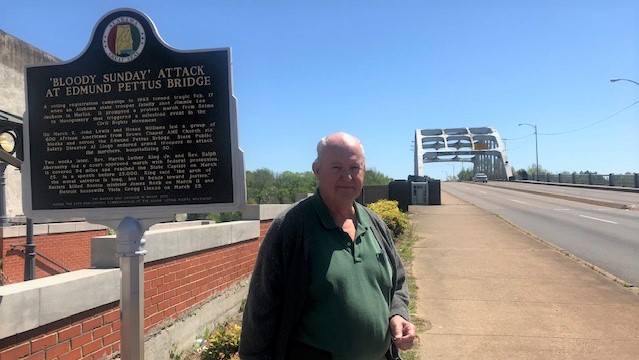
We headed for Selma and Montgomery next. We traveled a bit off the Interstate into the extreme Northwest Corner of Florida for the sole reason that our Jayco Skylark trailer would earn the right to apply that state sticker to a map in the back that shows all the states in which it has traveled. It was one of the most difficult drives as we headed up I-65. The weather was cloudy and occasionally rainy and the interstate (two lanes in each direction) was clogged with trucks and cars. That’s why we love to get off the interstate when we can, but it wasn’t feasible that day. Our main stop for the day was at the Montgomery County Museum of Fine Arts (#26) (https://mmfa.org), where there was an amazing ceramics exhibit and enough other art to keep Cynthia occupied for two hours during which time Larry had a little nap.
We found a place to stay for two nights at another Corps of Engineers Campground, this time on the reservoir on the Alabama River. We have grown fond of these COE sites, because, like other facilities we can stay cheap ($13/night) on our Government “Senior Pass,” but unlike National Park service sites, these come with full hookups of water, electricity and sewer connections. We are way from the freeway and urban hub-bub and enjoying the tranquility of the riparian environment, the stillness broken only by the occasional hoot of an owl, the squirrels chirping and occasionally an RV door closing. Most campers are old folks like us, so there are not raucous parties going on.

We went 42 miles to Selma on April 1. There we visited the National Park Civil Rights Trail Visitor Center (#27) (www.nps.gov/semo), where we saw the events of early 1965 in which black residents of Dallas County were attempting to get registered to vote, but were being rebuffed by white officials. After one of the blacks was killed in the process, there was an attempt to march from Selma to the state capital in Montgomery that resulted in the “Bloody Sunday” on the Edmund Pettis bridge, in which many protestors were beaten by police with billy clubs. The national attention of this and the subsequent successful march to Montgomery helped lead to the passage of the Voting Rights Act of 1965. We also visited the Lowndes visitor center where there was a tent city in support of the marchers (one of three on the way to Montgomery).
We drove on into Montgomery on April 2 and visited the Rosa Parks Museum (#28) (www.troy.edu/rosaparks). Rosa Parks refusal to relinquish her seat resulted in her arrest in 1955, 10 years before the Selma to Montgomery march referred to above. The museum had a fascinating exhibit which re-enacts the events of her refusal and the subsequent year-long bus boycott, which ended when the U.S. Supreme Court ruled in her case that the bus system could not be segregated. We enjoyed walking up towards the State Capitol on a beautiful day to briefly view the Dexter Avenue Church were Martin Luther King preached before moving to Atlanta. Lunch was at “Chris’s Hot Dogs,” a more than 100 year-old hot dog stand that is now designated as an historical site.

What can I say? 

Alabama State Capitol, Montgomery
We finished our day by stopping in Tuskegee to visit the Tuskegee Institute National Historic Site (#29) (https://www.nps.gov/tuin) where we toured the George Washington Carver Museum and learned about Booker T. Washington, who founded the Tuskegee Institute (now University) and all of Carver’s many accomplishments, including that as an artist. Tuskegee is also famous as the training site of the Tuskegee Airmen, the first African American pilots in World War II (#30) (https://www.nps.gov/tuai), so we explored the preserved hangers at Moton Field to absorb more of their story.


Restored Trainer 
Moton Field, 1942
Recent comments